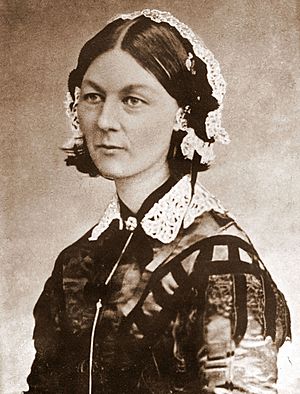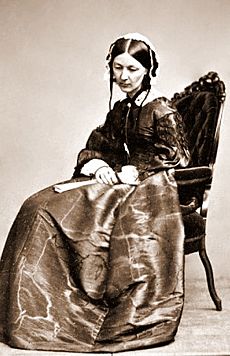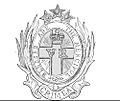Florence Nightingale facts for kids
Florence Nightingale (born May 12, 1820 – died August 13, 1910) was an English nurse. She helped create many of the modern ways we think about nursing today. She became a leader of nurses who cared for injured soldiers during the Crimean War.
Contents
- Early Life and Education
- Helping Soldiers in the Crimean War
- Starting a Nursing School
- Important Books and Ideas
- Focus on Statistics and Cleanliness
- Later Life and Death
- Her Personality and Friendships
- Interesting Facts About Florence Nightingale
- Florence Nightingale Quotes
- In Media
- Gallery
- Images for kids
- See also
Early Life and Education
Florence Nightingale was born in 1820 in Florence, Italy. She was named after the city where she was born. Her family was wealthy and moved back to London when she was young.
Florence's father taught her at home. She and her older sister, Parthenope, studied history, math, Italian, and other subjects. Florence was very good at collecting and understanding information, which helped her a lot later in life.
Even though her parents expected her to get married and have a family, Florence decided in 1845 that she wanted to become a nurse. Her family was upset by this, but she worked hard to learn about nursing.
In 1850, she visited a religious community in Germany called Kaiserswerth. There, she saw nurses helping sick and poor people. This experience changed her life, and she received four months of medical training.
In 1853, Florence became the superintendent at a hospital in London. Her father gave her money each year, which allowed her to live comfortably and focus on her nursing career.
Helping Soldiers in the Crimean War
In 1854, during the Crimean War, Florence heard many stories about how badly sick and injured soldiers were treated. She traveled to Crimea to see for herself. She found that the hospitals were very crowded and dirty.
She knew Sidney Herbert, who was in charge of war matters for the British government. He helped her go to the hospital in Istanbul where injured soldiers were sent. Florence quickly realized that more soldiers were dying from diseases like cholera than from their battle wounds.
She used her knowledge of math and statistics to show the British government that better hospital conditions would save lives and help them win the war. However, she was wrong about how cholera spread; she thought it was from bad air, not contaminated water.
While working in Crimea, Florence became known as "The Lady with the Lamp." This name came from a report in The Times newspaper. It said she would walk around the hospital at night with a lamp, checking on the soldiers:
She is a "ministering angel" without any exaggeration in these hospitals, and as her slender form glides quietly along each corridor, every poor fellow's face softens with gratitude at the sight of her. When all the medical officers have retired for the night and silence and darkness have settled down upon those miles of prostrate sick, she may be observed alone, with a little lamp in her hand, making her solitary rounds.
The poet Henry Wadsworth Longfellow also wrote a poem called "Santa Filomena" in 1857, which made the name even more popular:
Lo! in that house of misery
A lady with a lamp I see
Pass through the glimmering gloom,
And flit from room to room.
Starting a Nursing School
When Florence returned to England, she started a school for nurses in 1860 at St. Thomas’ Hospital in London. The first nurses trained by Nightingale began working in 1865. Today, this school is part of King's College London and is called the Florence Nightingale Faculty of Nursing and Midwifery.
Important Books and Ideas
Florence Nightingale wanted to share medical knowledge with everyone. Some of her books were written in simple English so that people with limited reading skills could understand them easily.
Her most important book was Notes on Nursing (1859). This book became the main textbook for her nursing school and other nursing programs. It was also popular with the general public and is still seen as a great introduction to nursing. Florence spent the rest of her life working to improve and organize the nursing profession.
She was also one of the first people to use graphs and diagrams to show information clearly.
Focus on Statistics and Cleanliness
Nightingale learned a lot about statistics from William Farr, a leading expert in public statistics. He helped her analyze all the information from the Crimean War. She showed that more soldiers died from diseases than from fighting. This was a very important discovery.
The main disease was cholera, which is caused by bacteria spread through dirty water. Sadly, both Florence and Farr believed that cholera was caused by bad air, a theory called the miasma theory.
Another person, John Snow, later proved that cholera was spread by contaminated water, not bad air. His work was published in 1855, but it took about 30 years for the germ theory to be fully accepted. Farr admitted he was wrong in 1866, but Nightingale never fully gave up her belief in the miasma idea. London's cholera problems stopped when authorities built better sewage systems and provided cleaner water.
Florence was also worried about the health of the British Army in India. Poor drainage, dirty water, crowded living spaces, and bad air circulation were causing many soldiers to die. She worked hard to improve cleanliness not only in the army but across the country. After 10 years of her efforts, the death rate among soldiers in India dropped significantly.
Later Life and Death
Florence Nightingale died peacefully in her sleep from a heart attack in 1910 in London. She is buried in the churchyard of St Margaret's Church in Wellow, Hampshire. A memorial to her was also created in Florence, Italy.
Her Personality and Friendships
Florence Nightingale was an amazing woman who went against what her family expected. She came from a wealthy family but chose to help the poor, injured, and sick instead of living a life of luxury.
As a young woman, she was described as attractive and charming. She had a long courtship with a politician named Richard Monckton Milnes, but she refused to marry him. She believed that marriage would stop her from following her calling to nursing.
Florence was a strong Christian but also believed that other religions had value. She was against discrimination of any kind. She felt that religion helped people find the strength to do difficult good work.
Important Friends
In 1838, Florence met Mary Clarke, an English woman living in Paris. Florence usually preferred the company of male thinkers, but she and Mary became close friends for 40 years. Mary showed Florence that women could be just as smart and capable as men.
In 1847, she met Sidney Herbert, a politician. They became lifelong friends. Herbert became the Secretary of War during the Crimean War. He and his wife were very important in helping Florence with her nursing work in Crimea. She became his main advisor throughout his political career.
Interesting Facts About Florence Nightingale

- In 1907, Florence Nightingale became the first woman to receive the Order of Merit. This is one of the highest honors given by the British monarch, King Edward VII.
- She also received the Royal Red Cross in 1883.
- She was known as 'The Lady with the Lamp' because she always carried a lamp when checking on wounded soldiers at night.
- As a young person, she traveled to Greece and Egypt.
- In Athens, Greece, she rescued a little owl from some children and named it Athena. She often carried the owl in her pocket.
- Florence Nightingale wrote a lot and lived to be 90 years old.
- There is a "Florence Nightingale Syndrome" named after her. It describes when a soldier falls in love with a nurse.
- Many statues of her are in Britain, including one in London. There is also a Florence Nightingale museum in London.
- Several hospitals in Istanbul, Turkey, are named after her.
- In 2002, she was ranked number 52 in the BBC's list of the 100 Greatest Britons.
- The US Navy ship USS Florence Nightingale (AP-70) was named after her in 1942.
- In 1981, an asteroid was named 3122 Florence in her honor.
- Her image has appeared on postage stamps in many countries.
Florence Nightingale Quotes
- “Rather, ten times, die in the surf, heralding the way to a new world, than stand idly on the shore.”
- “Live life when you have it. Life is a splendid gift-there is nothing small about it.”
- “I attribute my success to this: I never gave or took any excuse.”
In Media
Florence Nightingale's voice was recorded in 1890 and is kept in the British Library Sound Archive. In the recording, she says:
When I am no longer even a memory, just a name, I hope my voice may perpetuate the great work of my life. God bless my dear old comrades of Balaclava and bring them safe to shore. Florence Nightingale.
Her story has been told in many films and TV shows. For example, Kay Francis played her in the 1936 film The White Angel, and Anna Neagle starred in The Lady with a Lamp in 1951. An animated film about her was released in 1993.
Florence Nightingale's image also appeared on the back of British £10 banknotes from 1975 to 1994. She was shown with her lamp in a field hospital. Before 2002, she was the only woman (besides queens) to appear on British paper money.
Gallery
-
A drawing showing the evacuation of sick and injured soldiers from Balaklava
-
Nightingale's moccasins that she wore in the Crimean War
-
Florence Nightingale exhibit at Malvern Museum, England, 2010
-
Nightingale's medals displayed in the National Army Museum
-
Memorial to Nightingale, Church of Santa Croce, Florence, Italy
Images for kids
-
A print of the jewel awarded to Nightingale by Queen Victoria
-
The Lady with the Lamp. A popular drawing of Nightingale by Henrietta Rae, 1891.
-
Florence Nightingale by Charles Staal, engraved by G. H. Mote, used in Mary Cowden Clarke's Florence Nightingale (1857)
-
Blue plaque for Nightingale in South Street, Mayfair, London
-
Florence Nightingale Statue, London Road, Derby
-
Florence Nightingale stained glass window, now in St Peter's Church, Derby
-
Bust of Nightingale unveiled at Gun Hill Park in Aldershot in 2021
-
KLM MD-11 airplane, named Florence Nightingale
See also
In Spanish: Florence Nightingale para niños





























